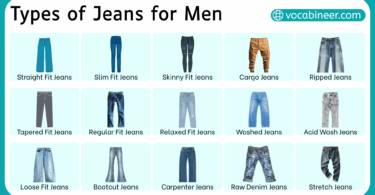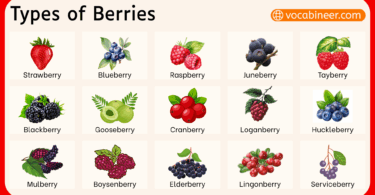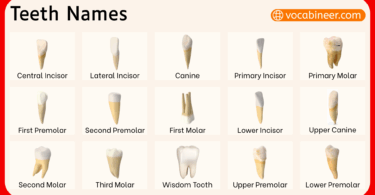The human body has many important parts, each with a specific name and function. Knowing human parts of body names and their functions shows how they work together to keep us healthy. For example, the heart pumps blood, the lungs help us breathe, and the brain controls everything. Let’s learn about these parts and how they help us every day!
Main Human Body Parts and Their Functions
The human body is made up of many parts, each with a specific role that helps us live, move, think, and feel. Below is a list of the main human body parts along with their basic functions. This section helps you understand what each part does in a simple and clear way.
In This Page
Head
- Brain — Controls the body’s actions, thoughts, memory, and emotions
- Eyes — Allow us to see
- Ears — Help us hear and maintain balance
- Nose — Used for breathing and smelling
- Mouth — Helps with speaking, eating, and tasting
- Teeth — Help break down food for digestion
- Tongue — Assists in tasting and speaking
Neck
- Throat — Carries air and food to the right places (windpipe and food pipe)
- Voice box (Larynx) — Produces sound for speaking
Upper Body
- Shoulders — Connect arms to the torso and help with movement
- Chest — Houses vital organs like the heart and lungs
- Heart — Pumps blood throughout the body
- Lungs — Help in breathing by taking in oxygen and removing carbon dioxide
Arms
- Upper arm, elbow, forearm — Allow flexible movement and strength
- Hands — Used for holding, touching, writing, and many daily tasks
- Fingers — Provide grip and precision
Abdomen
- Stomach — Breaks down food for digestion
- Liver — Filters blood and produces digestive bile
- Intestines (small and large) — Absorb nutrients and remove waste
Lower Body
- Hips — Support body weight and movement
- Legs (thigh, knee, calf) — Help in walking, running, and standing
- Feet — Provide balance and support body movement
- Toes — Help with walking and maintaining balance
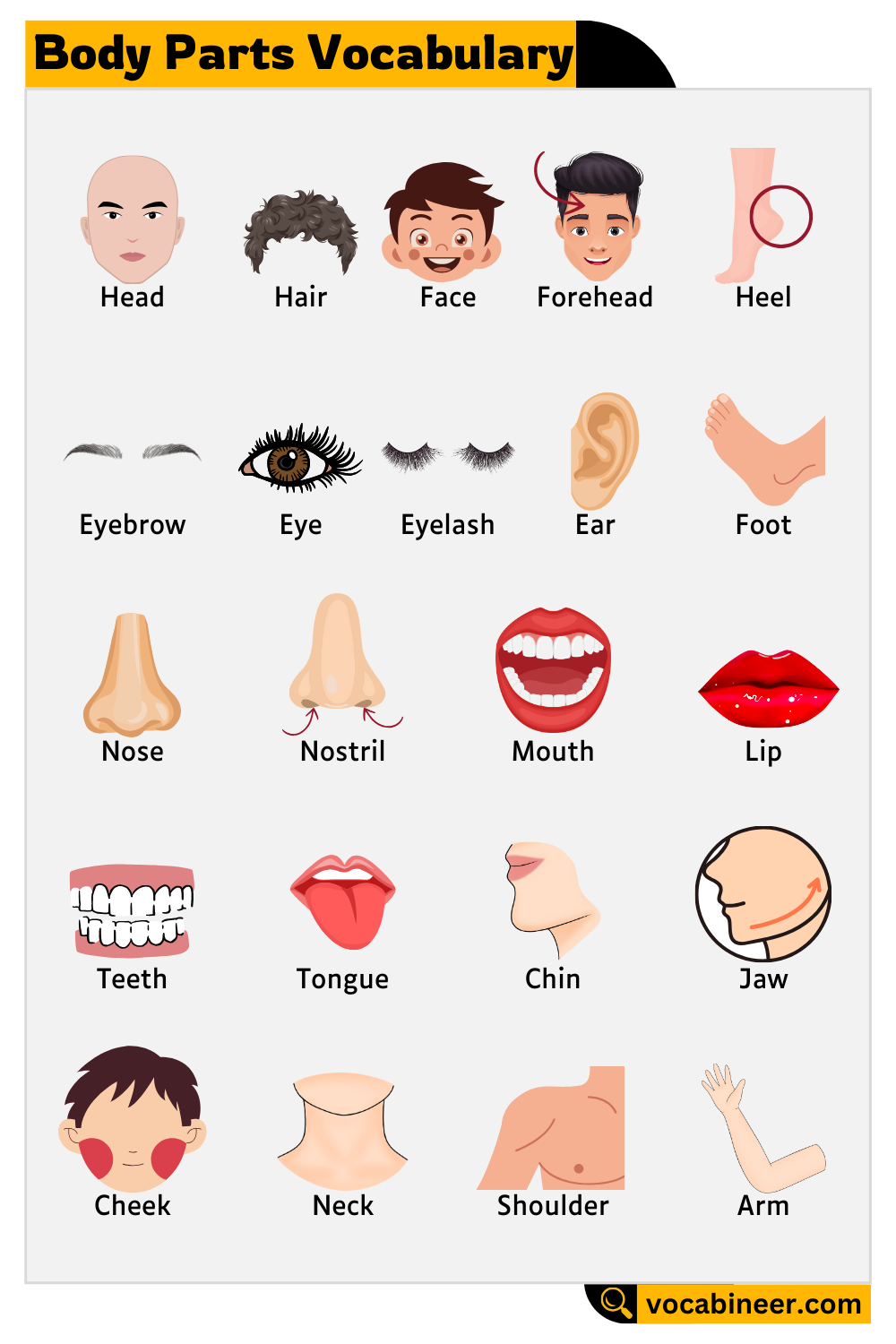
External Human Body Parts Names and Uses
External body parts are those we can see or touch. These parts help with movement, sensing the environment, and communication. Below is a list of external human body parts and their basic uses:
- Head — Holds the brain, eyes, ears, nose, and mouth
- Hair — Protects the scalp and provides insulation
- Forehead — Part of the face, supports expressions
- Eyes — Help us see and respond to light
- Ears — Allow us to hear sounds and maintain balance
- Nose — Helps us smell and breathe
- Mouth — Used for eating, speaking, and breathing
- Teeth — Help in chewing food
- Tongue — Helps in tasting and speaking
- Neck — Supports the head and connects it to the body
- Shoulders — Help arm movement and support load
- Arms — Help in lifting, holding, and actions
- Elbows — Allow arms to bend
- Hands — Help in touching, holding, writing, and working
- Fingers — Help in gripping and sensing
- Chest — Protects heart and lungs
- Back — Supports posture and movement
- Waist — Connects upper and lower body
- Hips — Help in walking and sitting
- Legs — Used for walking and running
- Knees — Allow leg movement
- Feet — Support body weight and help us walk
- Toes — Provide balance while standing or walking
Internal Body Parts with Functions
Internal parts are organs and tissues located inside the body. Each one performs a vital task. Below is a list of common internal human body parts with their functions:
- Brain — Controls thoughts, memory, and body movements
- Heart — Pumps blood throughout the body
- Lungs — Help us breathe by taking in oxygen and removing carbon dioxide
- Stomach — Breaks down food into nutrients
- Liver — Filters blood and helps in digestion
- Kidneys — Remove waste and excess water from the blood
- Intestines (Small and Large) — Absorb nutrients and remove waste
- Bladder — Stores and releases urine
- Esophagus — Carries food from mouth to stomach
- Pancreas — Produces enzymes and insulin
- Spleen — Helps in fighting infections
- Gallbladder — Stores bile for digestion
Human Sense Organs and Their Functions
We have five sense organs. These help us to understand and interact with the world around us. Below is a table of the five sense organs and what they do:
| Sense Organ | Function | Example |
|---|---|---|
| Eyes | Vision — help us see | We see colors, shapes |
| Ears | Hearing — detect sounds | We hear music, voices |
| Nose | Smell — detect scents | We smell flowers, food |
| Tongue | Taste — detects flavors | We taste sweet, sour |
| Skin | Touch — feels temperature, pressure | We feel heat, cold |
List of 50 Body Parts Name in English
Below is a list of 50 human body parts names in English:
- Head
- Hair
- Forehead
- Eye
- Eyebrow
- Eyelash
- Nose
- Ear
- Mouth
- Lip
- Tooth
- Tongue
- Chin
- Neck
- Shoulder
- Arm
- Elbow
- Wrist
- Hand
- Finger
- Thumb
- Chest
- Back
- Waist
- Hip
- Stomach
- Navel
- Leg
- Thigh
- Knee
- Calf
- Ankle
- Heel
- Foot
- Toe
- Brain
- Heart
- Lung
- Liver
- Kidney
- Intestine
- Bladder
- Bone
- Muscle
- Skin
- Blood
- Vein
- Nail
- Joint
- Spine
Human Body Systems and Key Organs
The human body is made up of systems that work together. Each system has organs that help it function. Below is a list of major body systems and key organs involved:
- Circulatory System — Heart, blood, veins, arteries
- Respiratory System — Nose, trachea, lungs
- Digestive System — Mouth, stomach, intestines, liver
- Nervous System — Brain, spinal cord, nerves
- Muscular System — Muscles
- Skeletal System — Bones, joints
- Excretory System — Kidneys, bladder
- Endocrine System — Glands (thyroid, pancreas)
- Reproductive System — Ovaries, uterus (female); testes, penis (male)
- Integumentary System — Skin, hair, nails
Parts of the Body List for Kids with Pictures
When teaching kids, it’s helpful to show pictures of body parts. This builds vocabulary and helps them understand location and use. Common parts to teach include:
- Head
- Eyes
- Ears
- Nose
- Mouth
- Teeth
- Tongue
- Neck
- Arms
- Hands
- Fingers
- Chest
- Legs
- Knees
- Feet
- Toes
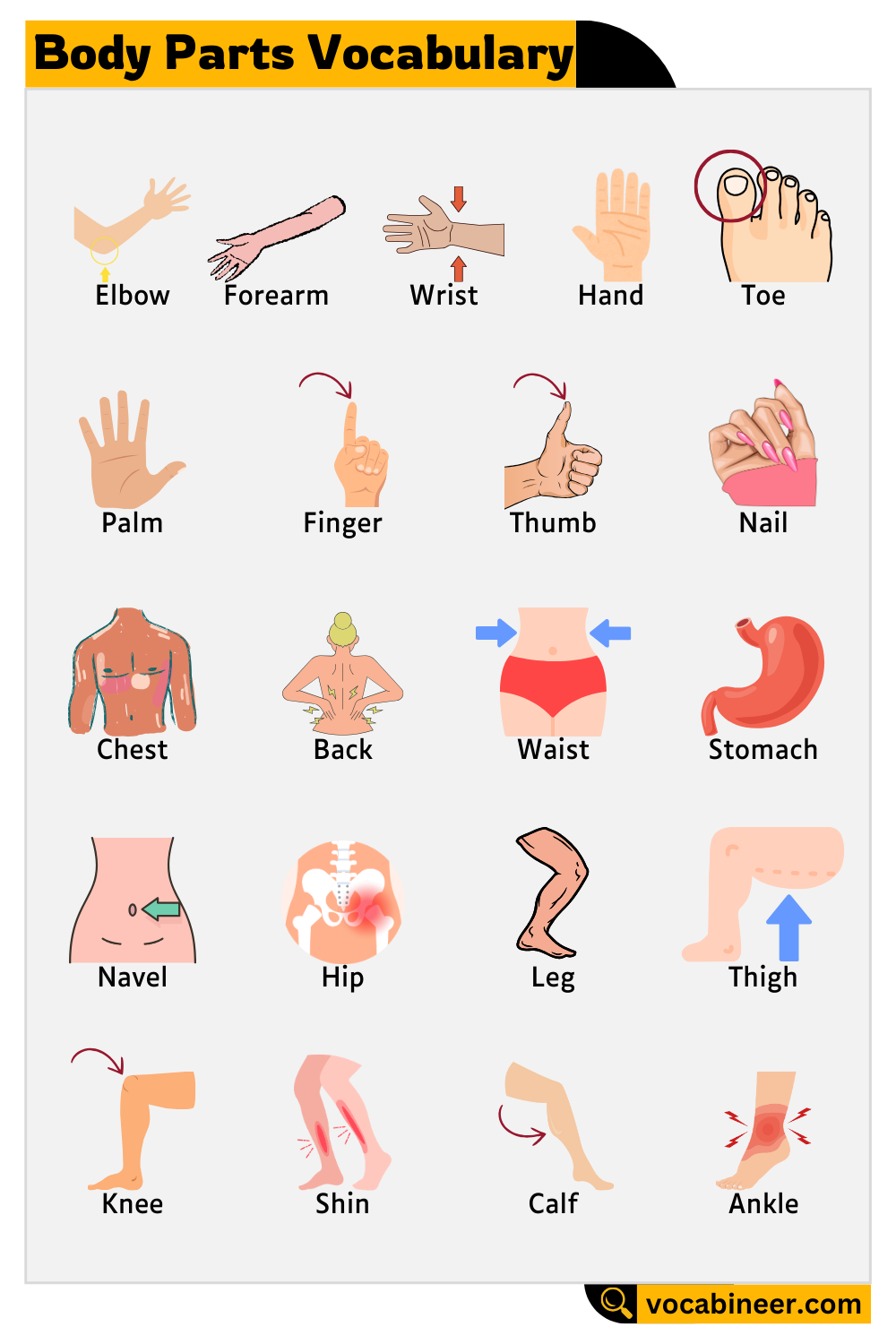
Human Body Parts List from Head to Toe
Below is a full list of body parts from head to toe:
- Hair
- Scalp
- Forehead
- Eyes
- Eyebrows
- Eyelashes
- Nose
- Cheeks
- Ears
- Mouth
- Lips
- Teeth
- Tongue
- Chin
- Jaw
- Neck
- Shoulders
- Arms
- Elbows
- Wrists
- Hands
- Fingers
- Chest
- Abdomen
- Waist
- Hips
- Thighs
- Knees
- Legs
- Ankles
- Feet
- Toes
Importance of Learning Body Parts and Functions
Understanding body parts and their functions is important for daily health, communication, and learning. Here’s why:
- Helps explain pain or injury (e.g., “My knee hurts”)
- Improves vocabulary and language skills
- Encourages personal hygiene and self-care
- Builds science knowledge for students
- Aids in emergency or first aid situations
- Supports healthy habits and fitness
Human Body Parts Name Chart with Pictures

| Body Part Name | Location | Simple Function |
|---|---|---|
| Head | Top of the body | Holds the brain and sense organs |
| Hair | On the head | Protects the scalp, adds appearance |
| Forehead | Front of head | Protects the brain’s frontal lobe |
| Eye | Face | Helps in seeing |
| Eyebrow | Above eyes | Keeps sweat out of eyes |
| Eyelash | Eyelids | Protects eyes from dust |
| Ear | Side of head | Used for hearing and balance |
| Nose | Face | Smelling and breathing |
| Cheek | Face | Covers cheekbones |
| Mouth | Face | Speaking, eating |
| Teeth | Inside mouth | Chewing food |
| Tongue | Inside mouth | Tasting and speaking |
| Chin | Lower face | Shapes the face |
| Neck | Below head | Supports the head, connects to torso |
| Shoulder | Upper torso | Helps arm movement |
| Arm | Upper limb | Lifting and movement |
| Elbow | Mid-arm joint | Bends the arm |
| Wrist | Arm joint | Bends the hand |
| Hand | End of arm | Grasping and feeling |
| Finger | On hand | Holding, touching |
| Chest | Upper torso | Protects heart and lungs |
| Heart | Inside chest | Pumps blood |
| Lung | Inside chest | Breathing |
| Stomach | Mid-torso | Digests food |
| Waist | Middle body | Separates upper and lower body |
| Back | Rear torso | Supports upright posture |
| Spine | Along back | Supports movement and nerve signals |
| Hip | Below waist | Helps with leg movement |
| Leg | Lower limb | Walking and standing |
| Thigh | Upper leg | Supports walking and running |
| Knee | Leg joint | Bends the leg |
| Calf | Back of leg | Aids in walking |
| Ankle | Above foot | Connects leg and foot |
| Foot | Bottom limb | Walking and balance |
| Toe | End of foot | Helps balance and motion |
| Skin | All over body | Protects organs, regulates temperature |
| Nails | On fingers/toes | Protects tips of fingers and toes |
| Brain | Inside skull | Controls all body functions |
| Liver | Right abdomen | Cleans blood, makes bile |
| Kidney | Lower back | Filters waste from blood |
| Intestines | Inside abdomen | Absorb nutrients, expel waste |
| Bladder | Lower abdomen | Stores urine |
| Bones | All over body | Provide structure and support |
| Muscles | All over body | Help in movement |
| Veins | Inside body | Carry blood to the heart |
| Nerves | All over body | Send signals to and from the brain |
FAQs about Human Parts of Body
The main body parts include the head, torso, arms, hands, legs, and feet. Each part has specific functions related to movement, sensation, and overall body support.
The five major organs are the brain, heart, lungs, liver, and kidneys. These organs control essential functions like thinking, breathing, and digestion.
A thumb is opposable and allows gripping, whereas fingers provide dexterity and fine movements.
The calf muscle (gastrocnemius) and the jaw muscle (masseter) are among the strongest muscles, helping with movement and chewing.
Read More


